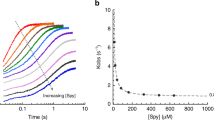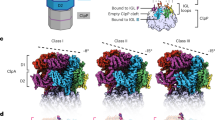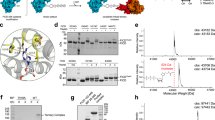Abstract
Molecular chaperones have evolved diverse tertiary and quaternary structures to stabilize non-native polypeptides and facilitate their transition to the native state. Indeed, different families of chaperones lack sequence similarity, and few are represented ubiquitously in all three domains of life. Despite their discrete evolutionary paths, recent crystal structures reveal that many chaperones use seemingly convergent strategies to bind non-native proteins. This crystallographic evidence shows, or strongly suggests, that chaperones including prefoldin, Skp, trigger factor, Hsp40 and Hsp90 have clamp-like structural features used to grip substrate proteins. We explore the notion that clamp-like structures are evolutionarily favored by both ATP-dependent and ATP-independent molecular chaperones. Presumably, clamps present a multivalent binding surface ideal for protecting unstable protein conformers until they reach the native state or are transferred to another component of the folding machinery.
This is a preview of subscription content, access via your institution
Access options
Subscribe to this journal
Receive 12 print issues and online access
$189.00 per year
only $15.75 per issue
Buy this article
- Purchase on Springer Link
- Instant access to full article PDF
Prices may be subject to local taxes which are calculated during checkout




Similar content being viewed by others
References
Frydman, J. Folding of newly translated proteins in vivo: the role of molecular chaperones. Annu. Rev. Biochem. 70, 603–647 (2001).
Hartl, F.U. & Hayer-Hartl, M. Protein folding—molecular chaperones in the cytosol: from nascent chain to folded protein. Science 295, 1852–1858 (2002).
Stirling, P.C., Lundin, V.F. & Leroux, M.R. Getting a grip on non-native proteins. EMBO Rep. 4, 565–570 (2003).
Wickner, S., Maurizi, M.R. & Gottesman, S. Posttranslational quality control: folding, refolding, and degrading proteins. Science 286, 1888–1893 (1999).
Neupert, W. Protein import into mitochondria. Annu. Rev. Biochem. 66, 863–917 (1997).
Hesterkamp, T., Hauser, S., Lutcke, H. & Bukau, B. Escherichia coli trigger factor is a prolyl isomerase that associates with nascent polypeptide chains. Proc. Natl Acad. Sci. USA 93, 4437–4441 (1996).
Kramer, G. et al. L23 protein functions as a chaperone docking site on the ribosome. Nature 419, 171–174 (2002).
Gautschi, M. et al. RAC, a stable ribosome-associated complex in yeast formed by the DnaK-DnaJ homologs Ssz1p and zuotin. Proc. Natl Acad. Sci. USA 98, 3762–3767 (2001).
Gautschi, M., Mun, A., Ross, S. & Rospert, S. A functional chaperone triad on the yeast ribosome. Proc. Natl Acad. Sci. USA 99, 4209–4214 (2002).
Hundley, H.A., Walter, W., Bairstow, S. & Craig, E.A. Human Mpp11 J protein: ribosome-tethered molecular chaperones are ubiquitous. Science 308, 1032–1034 (2005).
Macario, A.J. & Conway De Macario, E. The molecular chaperone system and other anti-stress mechanisms in archaea. Front. Biosci. 6, D262–D283 (2001).
Geissler, S., Siegers, K. & Schiebel, E. A novel protein complex promoting formation of functional alpha- and gamma-tubulin. EMBO J. 17, 952–966 (1998).
Martin-Benito, J. et al. Structure of eukaryotic prefoldin and of its complexes with unfolded actin and the cytosolic chaperonin CCT. EMBO J. 21, 6377–6386 (2002).
Leroux, M.R. et al. MtGimC, a novel archaeal chaperone related to the eukaryotic chaperonin cofactor GimC/prefoldin. EMBO J. 18, 6730–6743 (1999).
Siegers, K. et al. Compartmentation of protein folding in vivo: sequestration of non-native polypeptide by the chaperonin-GimC system. EMBO J. 18, 75–84 (1999).
Vainberg, I.E. et al. Prefoldin, a chaperone that delivers unfolded proteins to cytosolic chaperonin. Cell 93, 863–873 (1998).
Leroux, M.R. & Hartl, F.U. Protein folding: versatility of the cytosolic chaperonin TRiC/CCT. Curr. Biol. 10, R260–R264 (2000).
Spiess, C., Meyer, A.S., Reissmann, S. & Frydman, J. Mechanism of the eukaryotic chaperonin: protein folding in the chamber of secrets. Trends Cell Biol. 14, 598–604 (2004).
Hohfeld, J., Cyr, D.M. & Patterson, C. From the cradle to the grave: molecular chaperones that may choose between folding and degradation. EMBO Rep. 2, 885–890 (2001).
Bulieris, P.V., Behrens, S., Holst, O. & Kleinschmidt, J.H. Folding and insertion of the outer membrane protein OmpA is assisted by the chaperone Skp and by lipopolysaccharide. J. Biol. Chem. 278, 9092–9099 (2003).
Bitto, E. & McKay, D.B. Crystallographic structure of SurA, a molecular chaperone that facilitates folding of outer membrane porins. Structure 10, 1489–1498 (2002).
Webb, C.T., Gorman, M.A., Lazarou, M., Ryan, M.T. & Gulbis, J.M. Crystal structure of the mitochondrial chaperone TIM9.10 reveals a six-bladed alpha-propeller. Mol. Cell 21, 123–133 (2006).
Ferbitz, L. et al. Trigger factor in complex with the ribosome forms a molecular cradle for nascent proteins. Nature 431, 590–596 (2004).
Korndorfer, I.P., Dommel, M.K. & Skerra, A. Structure of the periplasmic chaperone Skp suggests functional similarity with cytosolic chaperones despite differing architecture. Nat. Struct. Mol. Biol. 11, 1015–1020 (2004).
Li, J., Oian, X.G. & Sha, B. The crystal structure of the yeast Hsp40 Ydj1 complexed with its peptide substrate. Structure 11, 1475–1483 (2003).
Ludlam, A.V., Moore, B.A. & Xu, Z. The crystal structure of ribosomal chaperone trigger factor from Vibrio cholerae. Proc. Natl Acad. Sci. USA 101, 13436–13441 (2004).
Sha, B., Lee, S. & Cyr, D.M. The crystal structure of the peptide-binding fragment from the yeast Hsp40 protein Sis1. Structure 8, 799–807 (2000).
Siegert, R., Leroux, M.R., Scheufler, C., Hartl, F.U. & Moarefi, I. Structure of the molecular chaperone prefoldin: unique interaction of multiple coiled coil tentacles with unfolded proteins. Cell 103, 621–632 (2000).
Walton, T.A. & Sousa, M.C. Crystal structure of Skp, a prefoldin-like chaperone that protects soluble and membrane proteins from aggregation. Mol. Cell 15, 367–374 (2004).
Harris, S.F., Shiau, A.K. & Agard, D.A. The crystal structure of the carboxy-terminal dimerization domain of htpG, the Escherichia coli Hsp90, reveals a potential substrate binding site. Structure 12, 1087–1097 (2004).
Huai, Q. et al. Structures of the N-terminal and middle domains of E. coli Hsp90 and conformation changes upon ADP binding. Structure 13, 579–590 (2005).
Zhu, X. et al. Structural analysis of substrate binding by the molecular chaperone DnaK. Science 272, 1606–1614 (1996).
Ali, M.M. et al. Crystal structure of an Hsp90-nucleotide-p23/Sba1 closed chaperone complex. Nature 440, 1013–1017 (2006).
Lu, J. & Deutsch, C. Folding zones inside the ribosomal exit tunnel. Nat. Struct. Mol. Biol. 12, 1123–1129 (2005).
Woolhead, C.A., McCormick, P.J. & Johnson, A.E. Nascent membrane and secretory proteins differ in FRET-detected folding far inside the ribosome and in their exposure to ribosomal proteins. Cell 116, 725–736 (2004).
Ban, N., Nissen, P., Hansen, J., Moore, P.B. & Steitz, T.A. The complete atomic structure of the large ribosomal subunit at 2.4 angstrom resolution. Science 289, 905–920 (2000).
Kramer, G. et al. Trigger factor peptidyl-prolyl cis/trans isomerase activity is not essential for the folding of cytosolic proteins in Escherichia coli. J. Biol. Chem. 279, 14165–14170 (2004).
Hesterkamp, T., Deuerling, E. & Bukau, B. The amino-terminal 118 amino acids of Escherichia coli trigger factor constitute a domain that is necessary and sufficient for binding to ribosomes. J. Biol. Chem. 272, 21865–21871 (1997).
Behrens, S., Maier, R., de Cock, H., Schmid, F.X. & Gross, C.A. The SurA periplasmic PPIase lacking its parvulin domains functions in vivo and has chaperone activity. EMBO J. 20, 285–294 (2001).
Schulze-Gahmen, U. et al. Structure of the hypothetical Mycoplasma protein MPN555 suggests a chaperone function. Acta Crystallogr. D Biol. Crystallogr. 61, 1343–1347 (2005).
Mayer, M.P. et al. Multistep mechanism of substrate binding determines chaperone activity of Hsp70. Nat. Struct. Biol. 7, 586–593 (2000).
Jiang, J., Prasad, K., Lafer, E.M. & Sousa, R. Structural basis of interdomain communication in the Hsc70 chaperone. Mol. Cell 20, 513–524 (2005).
Lee, S., Fan, C.Y., Younger, J.M., Ren, H. & Cyr, D.M. Identification of essential residues in the type II Hsp40 Sis1 that function in polypeptide binding. J. Biol. Chem. 277, 21675–21682 (2002).
Rudiger, S., Germeroth, L., Schneider-Mergener, J. & Bukau, B. Substrate specificity of the DnaK chaperone determined by screening cellulose-bound peptide libraries. EMBO J. 16, 1501–1507 (1997).
Rudiger, S., Schneider-Mergener, J. & Bukau, B. Its substrate specificity characterizes the DnaJ co-chaperone as a scanning factor for the DnaK chaperone. EMBO J. 20, 1042–1050 (2001).
Okochi, M. et al. Kinetics and binding sites for interaction of the prefoldin with a group II chaperonin—contiguous non-native substrate and chaperonin binding sites in the archaeal prefoldin. J. Biol. Chem. 279, 31788–31795 (2004).
Lundin, V.F. et al. Molecular clamp mechanism of substrate binding by hydrophobic coiled-coil residues of the archaeal chaperone prefoldin. Proc. Natl Acad. Sci. USA 101, 4367–4372 (2004).
Siegers, K. et al. TRiC/CCT cooperates with different upstream chaperones in the folding of distinct protein classes. EMBO J. 22, 5230–5240 (2003).
Schafer, U., Beck, K. & Muller, M. Skp, a molecular chaperone of gram-negative bacteria, is required for the formation of soluble periplasmic intermediates of outer membrane proteins. J. Biol. Chem. 274, 24567–24574 (1999).
Koehler, C.M. et al. Tim9p, an essential partner subunit of Tim10p for the import of mitochondrial carrier proteins. EMBO J. 17, 6477–6486 (1998).
Vial, S. et al. Assembly of Tim9 and Tim10 into a functional chaperone. J. Biol. Chem. 277, 36100–36108 (2002).
Vergnolle, M.A. et al. Distinct domains of small Tims involved in subunit interaction and substrate recognition. J. Mol. Biol. 351, 839–849 (2005).
Rehling, P., Brandner, K. & Pfanner, N. Mitochondrial import and twin-pore translocase. Nat. Rev. Mol. Cell Biol. 5, 519–530 (2004).
Wiedemann, N., Pfanner, N. & Chacinska, A. Chaperoning through the mitochondrial intermembrane space. Mol. Cell 21, 145–148 (2006).
Young, J.C., Hoogenraad, N.J. & Hartl, F.U. Molecular chaperones Hsp90 and Hsp70 deliver preproteins to the mitochondrial import receptor Tom70. Cell 112, 41–50 (2003).
Zhao, R. et al. Navigating the chaperone network: an integrative map of physical and genetic interactions mediated by the hsp90 chaperone. Cell 120, 715–727 (2005).
Prodromou, C. et al. The ATPase cycle of Hsp90 drives a molecular 'clamp' via transient dimerization of the N-terminal domains. EMBO J. 19, 4383–4392 (2000).
Meyer, P. et al. Structural and functional analysis of the middle segment of hsp90: implications for ATP hydrolysis and client protein and cochaperone interactions. Mol. Cell 11, 647–658 (2003).
Young, J.C. & Hartl, F.U. Polypeptide release by Hsp90 involves ATP hydrolysis and is enhanced by the co-chaperone p23. EMBO J. 19, 5930–5940 (2000).
Lee, S. et al. The structure of ClpB: a molecular chaperone that rescues proteins from an aggregated state. Cell 115, 229–240 (2003).
Bochtler, M. et al. The structures of HsIU and the ATP-dependent protease HsIU-HsIV. Nature 403, 800–805 (2000).
Sousa, M.C. et al. Crystal and solution structures of an HslUV protease-chaperone complex. Cell 103, 633–643 (2000).
Haslbeck, M., Franzmann, T., Weinfurtner, D. & Buchner, J. Some like it hot: the structure and function of small heat-shock proteins. Nat. Struct. Mol. Biol. 12, 842–846 (2005).
Bracher, A. & Hartl, F.U. Hsp90 structure: when two ends meet. Nat. Struct. Mol. Biol. 13, 478–480 (2006).
Acknowledgements
We thank M. Sousa for the complete model of the Skp trimer and apologize to those colleagues whose work is not cited due to space restrictions. M.R.L. acknowledges funding support from the Canadian Institutes for Health Research (CIHR). M.R.L. holds scholar awards from CIHR and the Michael Smith Foundation for Health Research (MSFHR), and P.C.S. holds graduate scholarships from MSFHR and the Natural Sciences and Engineering Research Council of Canada.
Author information
Authors and Affiliations
Corresponding author
Ethics declarations
Competing interests
The authors declare no competing financial interests.
Rights and permissions
About this article
Cite this article
Stirling, P., Bakhoum, S., Feigl, A. et al. Convergent evolution of clamp-like binding sites in diverse chaperones. Nat Struct Mol Biol 13, 865–870 (2006). https://doi.org/10.1038/nsmb1153
Published:
Issue Date:
DOI: https://doi.org/10.1038/nsmb1153
This article is cited by
-
Inter-domain dynamics in the chaperone SurA and multi-site binding to its outer membrane protein clients
Nature Communications (2020)
-
Skp is a multivalent chaperone of outer-membrane proteins
Nature Structural & Molecular Biology (2016)
-
Degradation of HER2/neu by ANT2 shRNA suppresses migration and invasiveness of breast cancer cells
BMC Cancer (2010)
-
Crystal structure of an intramolecular chaperone mediating triple–β-helix folding
Nature Structural & Molecular Biology (2010)
-
Spatiotemporal association of DNAJB13 with the annulus during mouse sperm flagellum development
BMC Developmental Biology (2009)



